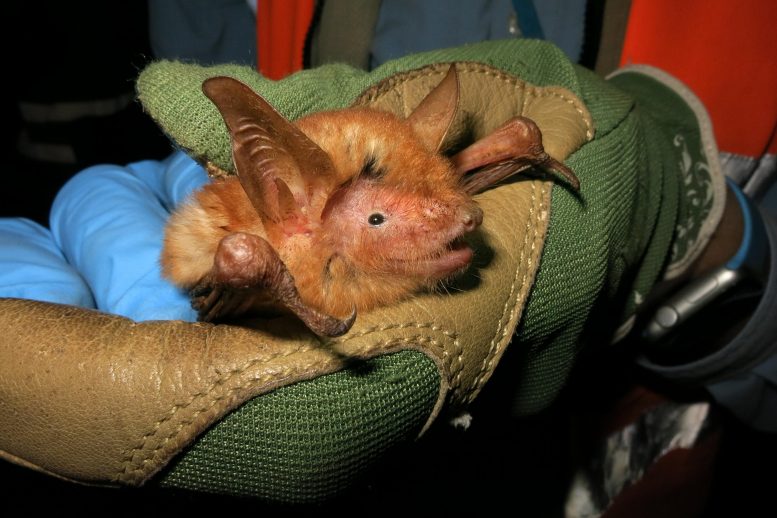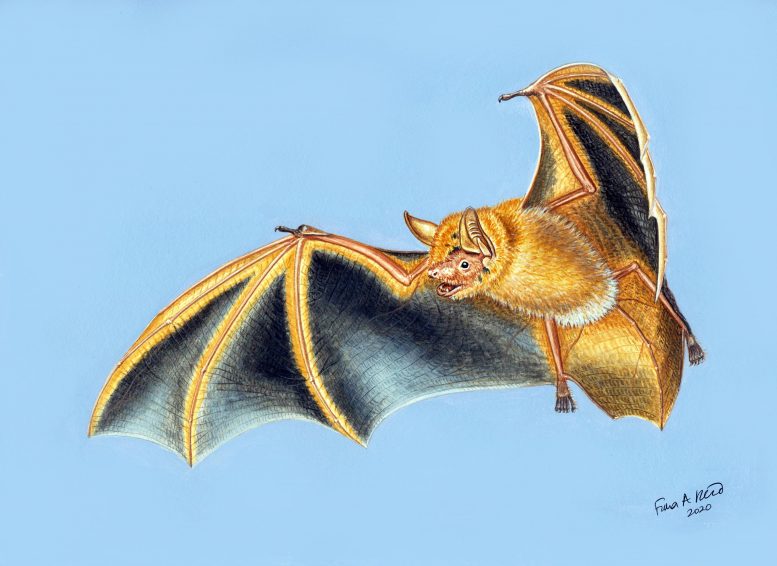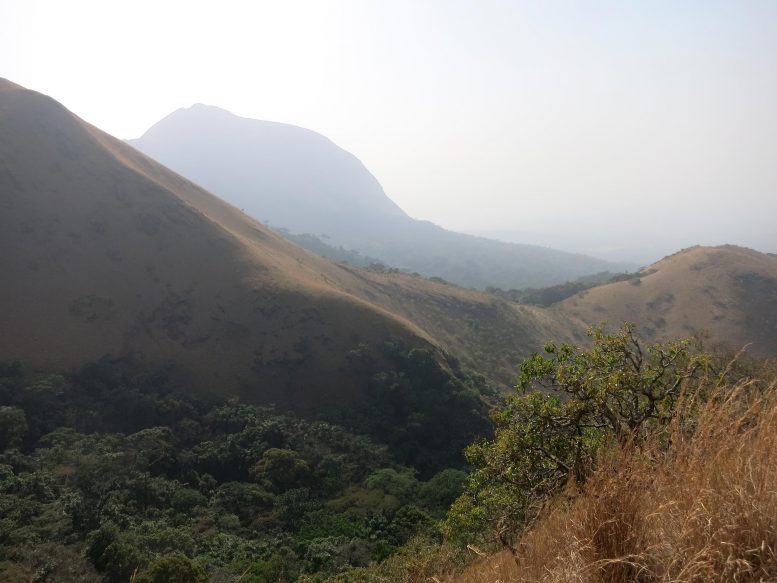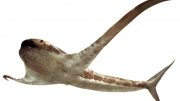
Myotis nimbaensis, shown here, is a new species of bat named for the mountain range in which it is found, the Nimba Mountains in West Africa. Credit: © Bat Conservation International
A group of scientists led by the American Museum of Natural History and Bat Conservation International have discovered a new species of a striking orange and black bat in a mountain range in West Africa. The species, which the researchers expect is likely critically endangered, underscores the importance of sub-Saharan “sky islands” to bat diversity. The species is described today in the journal American Museum Novitates.
“In an age of extinction, a discovery like this offers a glimmer of hope,” said Winifred Frick, chief scientist at Bat Conservation International and an associate research professor at the University of California, Santa Cruz. “It’s a spectacular animal. It has this bright-orange fur, and because it was so distinct, that led us to realize it was not described before. Discovering a new mammal is rare. It has been a dream of mine since I was a child.”

This illustration shows Myotis nimbaensis, a new species of bat found in the Nimba Mountains of West Africa. Credit: Fiona Reid
In 2018, Frick and her colleagues at Bat Conservation International and the University of Maroua in Cameroon were in the Nimba Mountains in Guinea conducting field surveys in natural caves and mining tunnels, known as adits, that were built in the 1970s and 1980s and have since been colonized by bats. In collaboration with the local mining company, Société des Mines de Fer de Guinée (SMFG), the scientists are trying to understand which bat species use which adits and at what times of the year.
Of particular interest is Lamotte’s roundleaf bat, Hipposideros lamottei, which is listed by the International Union for Conservation of Nature (IUCN) as critically endangered and has only ever been recorded in the Nimba Mountains. Much of its known population lives in the adits, which are in different states of collapse and will disappear in time. While surveying for this bat, the researchers found something peculiar — a bat that looked nothing like Lamotte’s roundleaf bat and did not match the descriptions of any other species that they knew occurred in the area. Later that night, they called on American Museum of Natural History Curator Nancy Simmons, a bat expert and chair of the Museum’s Department of Mammalogy, for help.
“As soon as I looked at it, I agreed that it was something new,” said Simmons, the lead author of the paper and Bat Conservation International Board member. “Then began the long path of documentation and gathering all the data needed to show that it’s indeed unlike any other known species.”

A chain of “African sky islands,” the Nimba Mountains in Guinea have peaks rising between 1,600-1,750 meters (about 1 mile) above sea level and are surrounded by drastically different lowland habitats. They are home to exceptional biodiversity, including bats. Credit: © Bat Conservation International
Through morphological, mor¬phometric, echolocation, and genetic data, including comparative data from collections at the Museum, the Smithsonian National Museum of Natural History, and the British Museum, the scientists described the new species, which they named Myotis nimbaensis (“from Nimba”) in recognition of the mountain range in which it is found. A chain of “African sky islands,” the Nimba Mountains have peaks rising between 1,600-1,750 meters (about 1 mile) above sea level and are surrounded by drastically different lowland habitats. As such, they are home to exceptional biodiversity, including bats.
“In addition to the Lamotte’s roundleaf bat, it’s possible Myotis nimbaensis could be the second bat species found only in this particular mountain range,” said Jon Flanders, Bat Conservation International’s director of endangered species interventions.
This study is part of an ongoing effort critical in helping the Nimba Mountain bats survive. Bat Conservation International and SMFG have already started working together to build new tunnels, reinforced to last for centuries and in habitat away from the mining project, for the Lamotte’s roundleaf bat. And although little is known yet about the population and range of Myotis nimbaensis, efforts like this will likely help it as well.
Reference: “A new dichromatic species of Myotis (Chiroptera: Vespertilionidae) from the Nimba Mountains, Guinea (American Museum novitates, no. 3963)” by Simmons, Nancy B.; Flanders, J.; Bakwo Fils, E. M.; Parker, Guy; Suter, Jamison D.; Bamba, Seinan; Keita, Mamady Kobele; Morales, Ariadna E.; Frick, Winifred F., 13 January 2021, American Museum Novitates.
URL
Other authors on the study include Eric Moïse Bakwo Fils from the University of Maroua; Guy Parker, Jamison Suter, and Seinan Bamba from SMFG; Mory Douno from the Ministry of the Environment, Water, and Forests in Guinea; Mamady Kobele Keita from Guinée Ecologie; and Ariadna Morales from the American Museum of Natural History and the Max Planck Institute of Molecular Cell Biology and Genetics, Dresden, Germany.









Where did these bats spend their days before the mining company drove the adits into the mountain? That question should be answered before willfully intervening in their roosting options. Might these good intentions place these bats at greater risk of social diseases by allowing larger numbers to congregate in small areas?
“The road to Hell is paved with good intentions.”